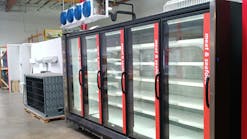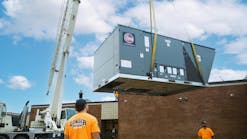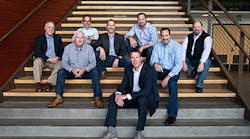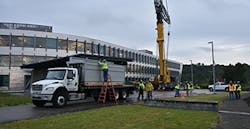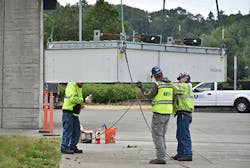From its origins as a small plumbing and heating shop in the early 1900s to its present-day success as a significant design-build mechanical contractor in the Pacific Northwest, University Mechanical Contractors (UMC) has evolved to meet the challenges of modern-day construction. Based in Mukilteo, Wash., just 25 miles north of Seattle, the firm has embraced prefabrication and modular construction to increase project productivity — and to help ensure the safety of its workers.
At UMC’s helm is President and CEO Jerry Bush, who began his career at UMC nearly 31 years ago, straight out of college with a degree in construction management. His family runs a plumbing and heating business in Colorado, so mechanical contracting was “in his blood from the get-go,” he notes.
Rounding out the executive management team is Pat Damitio, senior vice president of operations; Steve Brooks, PE, vice president of business development; Mark Faller, CFO; Kirk Baisch, safety director; Bryan Eppler, director of strategic development, energy and environment; David Malone, PE, director of preconstruction; and Steve Russo, PE, manager of major projects.
“When I started here, we prefabricated piping to some extent on projects,” Bush notes. “We've taken that to the next level, with regard to modular buildings, pre-manufactured components of buildings and our own manufactured products. It’s gone from basically a support unit to a standalone line of business that manufacturers and sells products — which still acts as a support structure for our construction projects.”
One of the products it manufactures came out of the COVID-19 pandemic: portable hand-washing stations. The idea came from UMC’s General Superintendent Matt Mifflin while at a jobsite; the company now manufactures and sells them to grocery stores and homeless shelters, as well as municipalities such as Seattle and New York City.
UMC’s original prefabrication facility was housed in 15,000 sq. ft. that it shared with warehousing. Today, the mechanical contractor has three separate facilities totaling 65,000 sq. ft.: one for miscellaneous metals and piping fabrication, one for modular and plumbing fabrication, and one for warehousing. And UMC sees more opportunities for modular construction.
Bush adds: “My prediction is that the traditional method of sending a couple of hundred men and women out with a bunch of materials and asking them to build a building is going to be a thing of the past.”
That mindset could be accelerated by COVID-19. Social distancing on a traditional jobsite will be a considerable challenge for the construction industry. Prefab and modular building, on the other hand, offer more controlled environments.
“The more that we can do offsite, the safer it is and the more efficient and effective it is as well,” Bush explains. “And the safety spans beyond just biological hazards like COVID-19. It's all-around a safer process in a manufacturing facility versus out in the field on the jobsite.”
UMC also specializes in energy efficiency projects — even before it was “in vogue,” Bush says. The energy services division was formalized in 2007.
“Our designers work with our customers to develop new, energy-efficient buildings,” he notes. “But we also have a lot of projects in our energy group retrofitting existing buildings, as well as campus development for district energy systems.”
One such project was the Federal Center South Building in Seattle, built for the General Services Administration on a brownfield site. At the time, it was the most energy-efficient building in the country with many cutting-edge, energy-efficient technologies: geothermal heat pumps, chilled beams, thermal storage, low-temp hot water and high-temp chilled water.
Strategic planning = growth
While UMC has always had a service group, but it became more of a priority about five years ago. “We heightened the level of priority to expand the size of this group for many reasons, not the least of which is it creates a much more valuable business as a whole,” notes Happel, who learned air conditioning while serving in the U.S. Navy. “It creates a current revenue stream for the organization and also allows us to be able to work with end-users more frequently.”
That focus was honed with a strategic plan set in motion three years ago to triple the size of the organization over five years. A little more than halfway into the program, UMC sees results.
“We created an entire sales organization within our facility services group that supports the mechanical service organization, as well as other parts of the business,” Happel says. “I believe we have six full-time salespeople now, and they're really driving the change that we've been looking for.”
That planning process also brought more attention to another essential part of a company’s success: people. With about 318 technicians and 156 office staff, UMC had a renewed commitment to focus on employees, customers and industry business partners.
“It has had more of an impact on our company than I think any of us imagined at the time,” Bush explains. “And it's pretty clear to us that the success we've had thus far through this crisis is largely attributed to the strategy that we've implemented and continue to implement in our company.”
To keep its competitive edge, UMC invests in its employees with ongoing training. As part of the strategic plan, the company hired a full-time training coordinator who implements a full training curriculum with a mix of industry programs and UMC-based education.
“Our technician coaching process helps us create our annual training curriculum,” Happel explains. “Every year, we spend a couple of hours with each technician at a supervisor level to understand how they're doing, what they need help with. At the end of the year, we chart the information to see how we are doing as an organization, and then overlay that on how we believe we need to be doing.”
While UMC’s 2020 revenue estimates are down slightly, which execs are OK with, the service group is helping clients whose businesses are starting to open back up.
“We've got an assessment plan where we're walking through buildings that have been sitting there empty for a while,” Bush notes. “Not only are we helping our customers get back up and running, but we’re also tweaking the systems if need be, adding filters, tweaking airflow, and giving recommendations to our customers on what they need to do to get back to business.”







